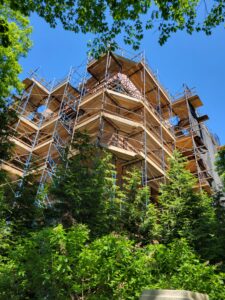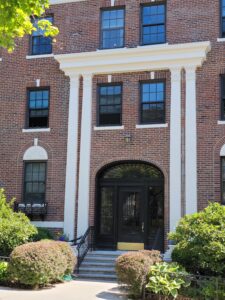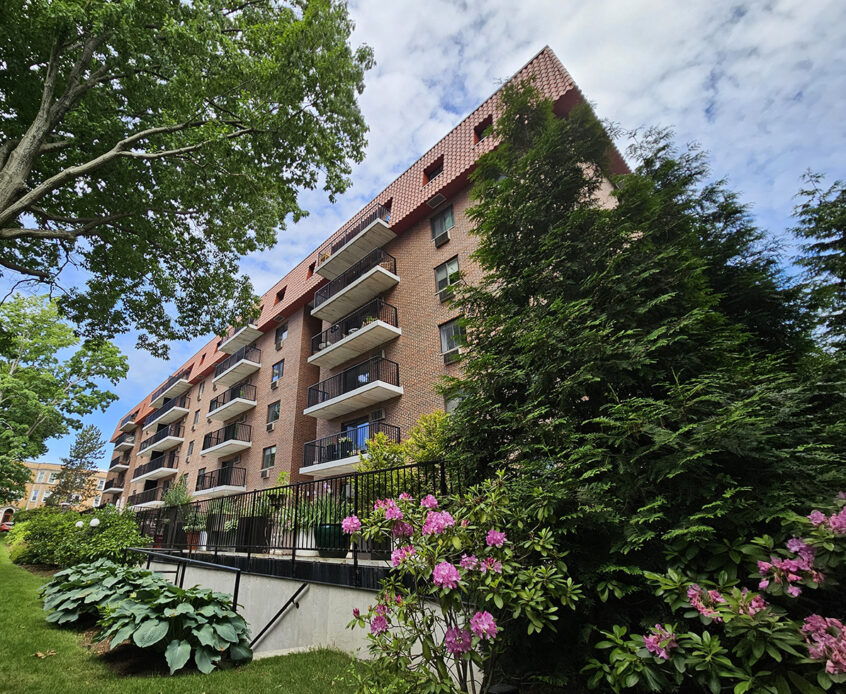Statewide is replacing balconies at 135 Pleasant St., Brookline.
The following article appeared in the August 2024 issue of Condo Media.
When retaining a masonry restoration contractor, it’s important to keep in mind that the restoration business requires expertise not only in “restoration,” but in “business.”
Much is at stake. You may be planning to spend hundreds of thousands of dollars – or even millions – on a restoration project. Your successful management of the project depends on your ability to retain a contractor who not only has deep experience and knowledge of the craft, but an understanding of how to manage a project from a business perspective.
Your management of the project depends on your ability to stay on budget, finish on time, minimize disturbances for owners and tenants, and, of course, provide top-quality results. A contractor with business skills can help you meet those goals.
Business Skills to Look For
What business skills should you look for in your restoration contractor?
Understanding of Logistics. On any given day, you may have a dozen or more subcontractors on site, waiting for guidance about what to do next. If their schedules are not coordinated, you will be paying them not to work. You’ll also be delaying the completion of your project.
Replacing balcony railings, as one example, may sound simple, but about 10 different processes take place on each balcony, including removing old railings, chipping away deteriorating concrete, striping off the old coating, patching and other structural repairs, application of the new coating and installation of new railings.

Scaffolding can reduce disruptions and noise for owners.
Efficient scheduling requires an understanding of the sequence of these processes and how long each will take to complete. That understanding is necessary to determine who needs to be where and when they need to be there to keep the project moving forward.
Regular onsite visits from the principal of the restoration company can help ensure that work is being completed and is at least satisfactory, but hopefully exceptional.
Possessing people skills. A typical project brings together many people with different skills, personalities, work ethics and agendas. The restoration contractor, like a conductor, needs to bring them all together in perfect harmony – or as close to perfect as is humanly possible.
While working closely with the property manager and the Board of Trustees, the restoration contractor also needs to work as part of a team with architects and engineers, the building supervisor, and many subcontractors. Having a building envelope consultant as part of the team is also advisable. And there are other stakeholders who also must be considered, including public officials and especially owners and tenants.
To keep all of these stakeholders happy, the restoration contractor must communicate regularly with each stakeholder. Communication skills are essential, as everyone needs to know what is expected of them and when. Sharing photos of work being done can be helpful, but in-person meetings are also needed for everyone involved to have a clear understanding of what needs to be done and sequentially how the work will be accomplished.
It helps if key people have experience working together, as they will know what to expect and who they can rely on. When everyone knows what to expect, obstacles and misunderstandings can usually be avoided.
Demonstrating professionalism. Some contractors in the building industry cut corners. They may not adequately bring your building up to current code standards. They may use inferior materials or they may not have the expertise to use certain materials.
When inferior materials are used, or when materials are misapplied, the project will ultimately fail. It may appear to be fine in the short-term, but before long you will be back to where you started. Leaks will reappear and your condominium will again look its age.
Your restoration contractor should stay current with new developments in the industry and should have close relationships with technical leaders in design, manufacturing, waterproofing, masonry restoration and other areas.
One sign that your restoration contractor is a business professional is if the company has achieved Approved Applicator status with key vendors. Leading manufacturers provide an Approved Applicator designation to a small number of contractors who have the expertise to use their products effectively. To encourage the use of Approved Applicators, they provide the security of an extended warranty for selected applications.
Being an active member of the New England Chapter of the Community Associations Institute is one way to stay current with all facets of the industry. A company that’s taking care of business is also fully licensed and fully insured, and can provide bid, payment and performance bonds.
Professionals also take responsibility for their work. They seek to avoid problems, but when problems arise, they address them quickly and move on.
Professionals also put safety first – the safety of their employees and subcontractors, but also of residents and others who will be onsite when work is taking place.
Understanding what’s needed. Retaining a contractor to fix leaks can mean anything from patching a few holes to replacing the entire building envelope.
Ideally, the restoration contractor and building envelope consultant should be involved from the beginning. If leaks need to be fixed, a thorough investigation of the roof should take place. If a building envelope is leaking, it’s essential to know what’s causing the leaks.
If what’s causing the leaks is not readily identifiable, part of the façade may have to be removed to determine what’s behind it. Doing so on one recent project, we found that the block backup wall had no waterproofing. In addition, the cavity wall was not functioning, as there was no cavity between the outer wythe of brick and the block backup wall.
Creating prototypes of balcony railings, lintels and other parts, and testing them to ensure that they fit and work properly, helps to ensure that the project will succeed.
This upfront work will save time and money, while helping to ensure that the work appropriately addresses your concerns. If the project isn’t well defined, expect frequent change orders, which will increase the overall cost and delay completion.
Adequate planning may delay the start of the project by three to five months, but ultimately it will save a great deal of time and money.
Working within the budget. Sometimes the best approach exceeds what the budget will allow. An experienced project team, with everyone working together, may be able to come up with a more affordable solution.
Instead of replacing the entire building envelope, for example, it may be possible to focus on the top floor, which is often the major source of leaks.

A deteriorating portico made from stamped concrete was replaced with this fiberglass entryway, updating the appearance and saving money.
Creative solutions may also be available. In one case, for example, it was cost prohibitive to replace a deteriorating portico with a new portico made from precast concrete. Instead, we created a new fiberglass cornice. In another case, working with a structural engineer, we were able to reinforce rather than replace the fifth floor of a building, saving about $1 million.
Sometimes a project can be divided into phases, so that it can be budgeted over two or more years. It’s better to do half of the project properly than to complete the entire project with inferior results.
Considering the needs of all stakeholders. A restoration project can be tough on owners and tenants. They have to live with noisy, dirty conditions and strong odors. They may have to give up access to part of their unit and the temporary loss of parking spaces.
To minimize the inconvenience for owners, the restoration contractor should keep as much work as possible outdoors. The installation of scaffolding is usually a necessity for a significant project covering multiple floors. Having workers hauling equipment, balcony railings and other heavy objects through the elevators may save money, but it’s a nuisance to those who live in the building.
The restoration contractor should do everything possible to minimize noise and disruption, keep work areas clean and maintain a friendly, respectful manner toward residents.
Checking your work. The restoration contractor should regularly check the work being done, but also when the project is completed. If the work is inspected thoroughly by the restoration contractor, the punch list for the final inspection should be negligible.
When choosing a restoration contractor, ask references not only about the quality of the company’s work, but about management’s business skills. There’s more to the restoration business than restoration.
Kieran Fitzgibbon is co-owner of Statewide RM of Brighton, Mass., which specializes in masonry restoration for condominiums. He can be reached at kfitzgibbon@statewiderm.com.

